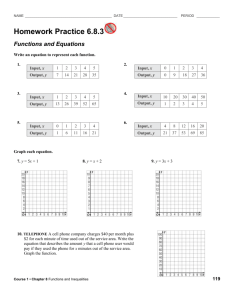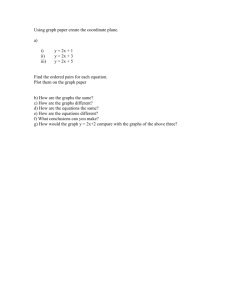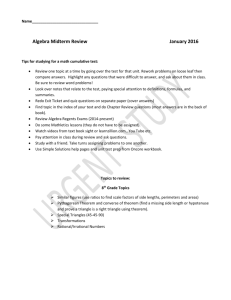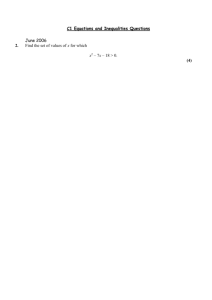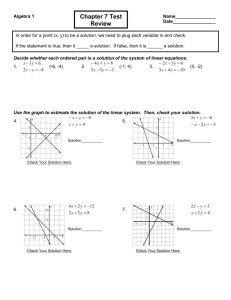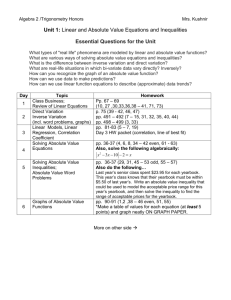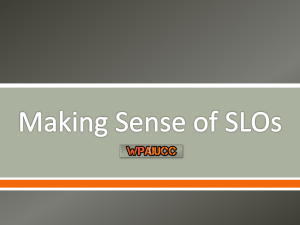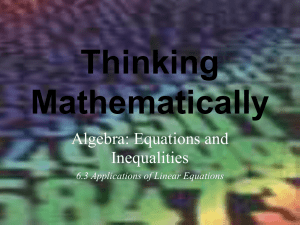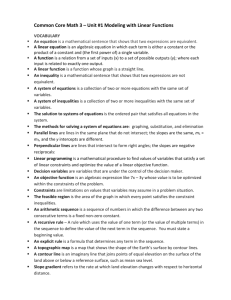Subject: Algebra I
advertisement
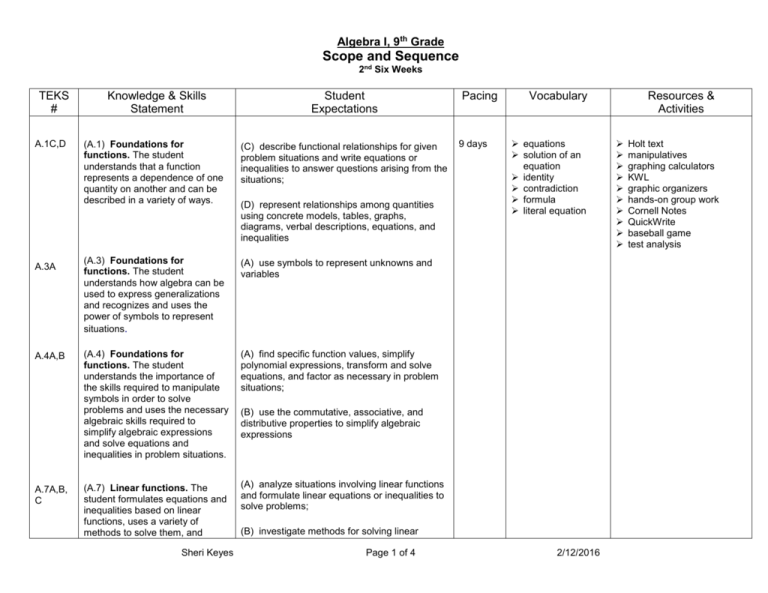
Algebra I, 9th Grade Scope and Sequence 2nd Six Weeks TEKS # A.1C,D A.3A A.4A,B A.7A,B, C Knowledge & Skills Statement Student Expectations (A.1) Foundations for functions. The student understands that a function represents a dependence of one quantity on another and can be described in a variety of ways. (C) describe functional relationships for given problem situations and write equations or inequalities to answer questions arising from the situations; (A.3) Foundations for functions. The student understands how algebra can be used to express generalizations and recognizes and uses the power of symbols to represent situations. (A) use symbols to represent unknowns and variables (A.4) Foundations for functions. The student understands the importance of the skills required to manipulate symbols in order to solve problems and uses the necessary algebraic skills required to simplify algebraic expressions and solve equations and inequalities in problem situations. (A) find specific function values, simplify polynomial expressions, transform and solve equations, and factor as necessary in problem situations; (A.7) Linear functions. The student formulates equations and inequalities based on linear functions, uses a variety of methods to solve them, and (A) analyze situations involving linear functions and formulate linear equations or inequalities to solve problems; Sheri Keyes (D) represent relationships among quantities using concrete models, tables, graphs, diagrams, verbal descriptions, equations, and inequalities Pacing 9 days Vocabulary equations solution of an equation identity contradiction formula literal equation (B) use the commutative, associative, and distributive properties to simplify algebraic expressions (B) investigate methods for solving linear Page 1 of 4 2/12/2016 Resources & Activities Holt text manipulatives graphing calculators KWL graphic organizers hands-on group work Cornell Notes QuickWrite baseball game test analysis Algebra I, 9th Grade Scope and Sequence 2nd Six Weeks analyzes the solutions in terms of the situation. equations and inequalities using concrete models, graphs, and the properties of equality, select a method, and solve the equations and inequalities; and (C) interpret and determine the reasonableness of solutions to linear equations and inequalities. A.1A,B, C,D,E (A.1) Foundations for functions. The student understands that a function represents a dependence of one quantity on another and can be described in a variety of ways. (A) describe independent and dependent quantities in functional relationships; (B) gather and record data and use data sets to determine functional relationships between quantities; (C) describe functional relationships for given problem situations and write equations or inequalities to answer questions arising from the situations; (D) represent relationships among quantities using concrete models, tables, graphs, diagrams, verbal descriptions, equations, and inequalities; and 5 days multiple representations concrete representation verbal representation numeric representation graphical representation algebraic representation generalize Distributive Property (E) interpret and make decisions, predictions, and critical judgments from functional relationships. A.2B,C (A.2) Foundations for functions. The student uses the properties and attributes of functions. (B) identify mathematical domains and ranges and determine reasonable domain and range values for given situations, both continuous and discrete; (C) interpret situations in terms of given graphs Sheri Keyes Page 2 of 4 2/12/2016 AgileMind lesson: Multiple Representations in the Real World AgileMind print materials Holt text manipulatives graphing calculators graphic organizers problem solving Algebra I, 9th Grade Scope and Sequence 2nd Six Weeks or creates situations that fit given graphs A.1A,B, C,D,E (A.1) Foundations for functions. The student understands that a function represents a dependence of one quantity on another and can be described in a variety of ways. (A) describe independent and dependent quantities in functional relationships; (B) gather and record data and use data sets to determine functional relationships between quantities; (C) describe functional relationships for given problem situations and write equations or inequalities to answer questions arising from the situations; (D) represent relationships among quantities using concrete models, tables, graphs, diagrams, verbal descriptions, equations, and inequalities; and 10 days function independent variable dependent variable constant coefficient y-intercept process domain range function rule evaluate ordered pair scatter plot (E) interpret and make decisions, predictions, and critical judgments from functional relationships. A.2B,C (A.2) Foundations for functions. The student uses the properties and attributes of functions. (B) identify mathematical domains and ranges and determine reasonable domain and range values for given situations, both continuous and discrete; (C) interpret situations in terms of given graphs or creates situations that fit given graphs A.3A,B (A.3) Foundations for functions. The student understands how algebra can be used to express generalizations and recognizes and uses the Sheri Keyes (A) use symbols to represent unknowns and variables; and (B) look for patterns and represent Page 3 of 4 2/12/2016 TexTeams lesson: Identifying Patterns Holt text graphic organizers manipulatives graphing calculators Cornell Notes QuickWrite hands-on group work test analysis Socratic Seminar baseball game Algebra I, 9th Grade Scope and Sequence 2nd Six Weeks A.5B power of symbols to represent situations. generalizations algebraically. (A.5) Linear functions. The student understands that linear functions can be represented in different ways and translates among their various representations. (B) determine the domain and range for linear functions in given situations Sheri Keyes Page 4 of 4 2/12/2016
